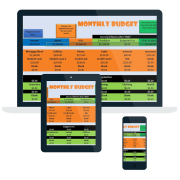If you want to manage anything in your life, you first have to measure it. Whether you’re trying to lose weight, train for a marathon, build a business, or take control of your finances, you must have a way to measure it.
“If you can’t measure it, you can’t manage it”
-Peter Drucker
Managing the Money
The only way to truly manage your money is to budget for it. Therefore, I have taken the above quote and applied a Money Peach feel to it:
“If you don’t budget-it, you can’t manage it”
-Chris Peach
Let’s think about this for a second…
If a business were to merely guess on the money coming in and the money going out each month, how long would that business last?
or…
If you were going on a road trip across the country, how comfortable would you feel driving if you didn’t have a fuel gauge?
The point is this: You must be doing a monthly budget.
Grab your Budget Right Here
Send Me the Budget

For those who will finally decide to take control of their money and lives by living on a budget, they can be broken down into two separate groups:
1. Steady Income Earners
2. Irregular Income Earners
Budgeting for Steady Income Earners
If you get paid the same or have a steady paycheck, you’ll want to read on here:
Budgeting with an Unsteady Paycheck (Irregular Income)
If you are someone who is self-employed, commission-only, or can’t rely on a steady income stream, then you’re going to get a ton of value thrown at you right now 🙂
Step-by-Step with an Unsteady Paycheck
Below is the step-by-step method for taking your complicated income stream and simplifying it to fit your lifestyle. Here at Money Peach, I like things simple, easy-to-implement, and with common sense when it pertains to money.
Now, let’s take that simplicity and apply it to your irregular income.
Step 1: Determine your total income over the last 90 days
Look over your income over the last 90 days to get an idea of how much you made in a quarter. This is going to help you determine how much you have each month to budget with, how much you need to set aside for taxes, and how much you need to keep as a “buffer”.
Step 2: Determine your NEEDS inside your Monthly Budget
What are the things this month that must get paid? These will be your mortgage/rent, food, electricity, food, gas for your car, tithing, and other bare necessities to keep you going each month.
We are determining our bare essentials here so we have an idea of how much you are going to NEED to set aside each month if the unsteady paycheck forgets to show up.
You can download the Pencil & Paper PDF or the Spreadsheet Budgeting Form right here to get started.
Step 3: Decide on your WANTS inside your Monthly Budget
This is the fun stuff inside your budget. The going-out-to-eat, the new dress, the new gadget for the house, and the cleaning lady for example. We can consider these things the luxuries in your life that you work hard for, but could also be put on hold if the money wasn’t there.
Step 4: What is your INCOME going to be?
The problem most people I do financial coaching for is they spend whatever is coming in for the month. This feels great when the checks come rolling in and feels beyond horrible when an entire month goes by without a penny coming in.
The solution – Create Your Own Steady Paycheck
After looking through your budget, you are going to determine ONE income for your budget based on both the NEEDS and WANTS from above.
Next, open up a separate Savings or Money Market Account at a separate bank.
Note: I highly recommend you open up an account at a bank away from your everyday-checking account. This will keep your checking account from borrowing from that Savings account 🙂
I Recommend CIT Bank
Open a Paycheck Fund
This new bank is going to feel like your new employer. If you are using CIT Bank, you can earn 1.55% on your savings, which will help you build your paycheck fund faster.
Next, you are going to start depositing all the irregular income into this account.
This account is going to “pay you” a steady income every month based on what you have decided your income to be inside your budget.
Step 5: Re-Evaluate Your Income at the End of Every Month
At the end of the month, you are going to have a new 90-day window to evaluate your income. Your income may have gone up, stayed the same, or gone down. Either way, this gives you the opportunity to forecast how much you will have available in next month’s budget, and therefore adjusting your “paycheck” from your Savings Account accordingly.
Why This Works
The vast majority of people I have coached will tell you this works because they have a plan for their irregular income when it arrives in their checking account.
The common mistake people make is they try to get ahead of the bills when large amounts of income are deposited all at once. However, the problems begin when we get ahead on one bill, fall behind on the other, and then you’re hit with a lousy month of income.
Therefore, instead of wishing you had a steady income to make budgeting work for you, you’re deciding to make a steady income so budgeting is easier for you.
Why the heck wasn’t this simple lesson taught in High School?!
Things You Must Consider
- If you are working with an irregular income stream, I highly recommend you build out a 6 month emergency reserve.
Related: Building Your Emergency Fund
- If you do not have taxes withheld from your paycheck, open up a second Savings Account or Money Market Account for Taxes, and pay your taxes quarterly. This will keep you closer to the actual amount you owe when breaking down quarterly versus trying to figure it all out at the end of the year.
Related: Self Employed Tax Considerations
- Do not mix your business expenses with your household expenses. You should treat them completely separate and create a budget for your household and a budget for your business. One of the greatest issues I see with self-employed business owners is when there isn’t a separation between the two.
- Don’t worry about being perfect in the beginning. I cannot stress this enough, but it usually takes 60 – 90 days to fully implement a budget. In the beginning, you’re not trying to be perfect, but instead you’re looking to make small amounts of daily progress. Capisce?
Show Me an Example
Step 1 – Determine Income
Hannah and Robert have a household gross income of around $100k/year.
Over the past 90 days, they have grossed (before taxes) $33k. After taxes set aside, they have a net quarterly earnings of $25k.
Step 2 – Determine Needs
They look at their budget and the decide the monthly NEEDS are $3,700/month
Step 3 – Determine Wants
They look at their budget and decide the monthly WANTS are $2,300/month
Step 4 – Determine your Income
They decide their monthly income is $6,000 ($3,700 + $2,300).
They open up a Savings account at CIT Bank and deposit all the money they have floating around from the last big paycheck into that account. From the $25,000, the still have $10,000 left over.
Hannah and Robert now take a steady paycheck of $3,000 on the 1st of the month and another $3,000 on the 15th of the month. They simply transfer this money from their CIT account into their everyday checking account.
They now have a steady paycheck 🙂
Step 5 – Re-evaluate
At the end of the month, Hannah and Robert realize they will not receive any income in the upcoming month due to sales from their commission-only job pending.
Since they still have $4,000 leftover in their Paycheck Fund, they together see the need to cut back the WANTS inside their budget in order to live off of the smaller $4,000 income stream from their Paycheck Fund.**
There you have it. It’s not rocket science, and we only went as far as 5th grade math.
**Note This is an example of exactly why I recommend those with an irregular income have a minimum 6 month Emergency Fund set aside
My Question for You
What do you think? Do you use this method, do you do something differently, and/or are you willing to give this a try?
I would love to hear back from you! Simply leave a comment at the bottom of the page.
If you Like it, Please Share it!
As always, I first want to thank you for reading this blog because this means you are reaching for awesome with your money! I will keep putting content out there for anyone to gobble up and implement right away, however if you could help me out by sharing this post on your favorite social media platforms, it would mean the world to me! Just click on any of the social share buttons at the top or bottom of this post and you’ll be giving me a virtual fist bump, high-five, and a pat on the back. Thank you again and again!
-Chris Peach







6 Comments
Great article.
I really like the simple but powerful step 2 – determine your needs. Easier by yourself but if done by a couple, they are already on the right path.
Right on! I will say easier and harder by yourself. When you’re doing this budget by yourself, your needs and wants may blend together and you don’t have an accountability partner to check you at the door.
I once say a lady who had 40+ purses and she was completely broke. I asked her why she had 40 purses and she told me whenever she felt broke, she would make herself feel better buying a purse.
She was single and didn’t have an accountability partner.
(She sold about 38 of them later on)
Great suggestions! Lots of successful budgeters I know pay themselves a steady paycheck out of their earnings just like you suggest.
It makes sense. If you can apply “steady” to anything in your life, you’re going to find it to be less of a pain in the butt. I also recommend doing this for any bills in your life that you can “equalize”, or to be the same each month. Many utilitiy and gas companies will allow you to average out the year to pay the same monthly payment which makes budgeting a heck-of-a-lot easier 🙂
I have become quite the penny pincher over the last few years as I found it empowering to see my savings accounts grow. Put a lot of time into thinking about what are actually wants and needs, and finding things to do that are fun but really don’t cost anything. Thanks for sharing!
Ahhhh yes Laurie! The WANTS vs the NEEDS. To tell you the truth, I think everyone battles with this a little bit. However, by simply paying attention to it and taking an extra second to ask yourself, “Do I really need this or do I just really want it” is a giant step in the right direction. Thanks for your comment Laurie! 🙂